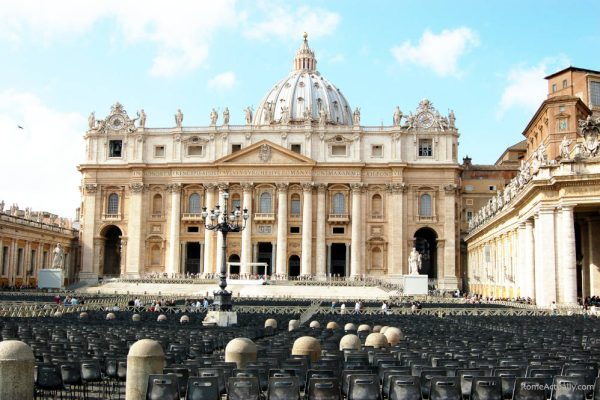One of the most famous and best landmarks to visit in Rome’s lovely Villa Torlonia park is its Casina delle Civette, the Italian for Owls’ House or Cottage. This was the former residence of the Torlonia Prince also during the Fascist regime when Benito Mussolini was renting and occupying the Casino Nobile with his family.
Casina delle Civette was the home of Giovanni Torlonia the young until he died in 1938. Its location behind a small hill made it a sort of hideout perfect as an escape from the public duties of the official residence.
A radiant tribute to art nouveau and Liberty style, the finely restored House of the Owls offers countless corners and crannies to discover and explore. Think bright colors, dazzling mosaics, stylized birds, and lots of stained glass doors and windows and you will start having an idea of what you are going to find when wandering the halls and corridors of Villa Torlonia’s Casina delle Civette.
Don’t miss our guide with 100+ things to do in Rome!
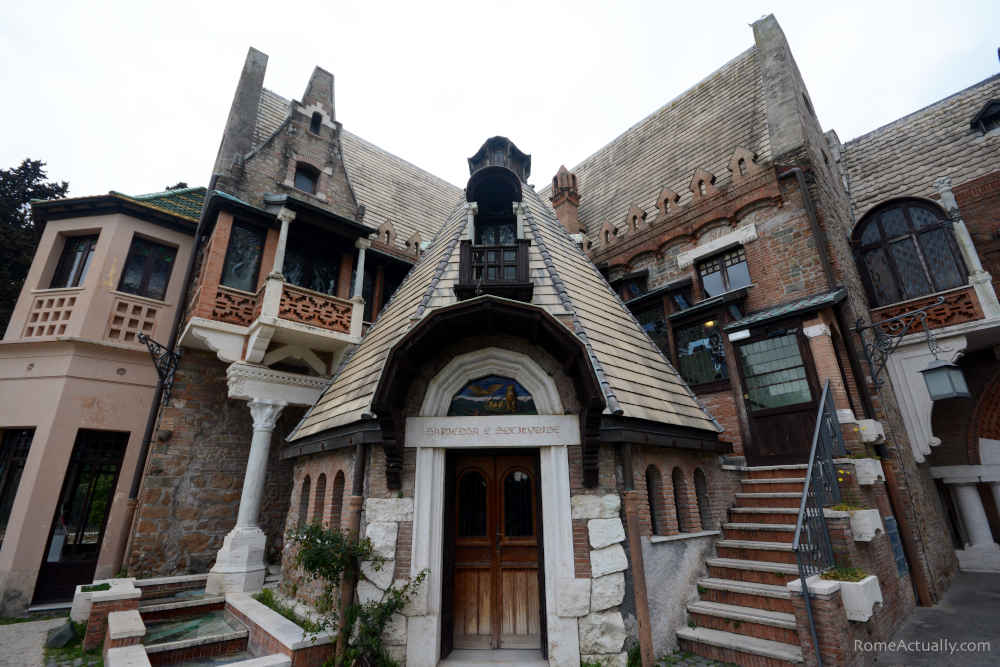
History of Casina delle Civette
The original construction of what today we know as Casina delle Civette is to be traced to 1840 and was designed by Venetian architect and engineer Giuseppe Jappelli. The exterior was deliberately given a rustic look with tuff ashlars while the interior was painted to mimic masonry and wooden tables.
However, already in 1908, the nephew of Alessandro, Giovanni Torlonia jr., commissioned a radical change and refurbishment that earned it the moniker of “medieval hamlet”. The work was given to local architect Enrico Gennari and this once rustic cottage started to evolve into a gracious and elegant residence embellished with large windows, small towers and lodges, and porticoes. The overall decoration included majolica ceramics and stained glasses.
The building started to be called the owls’ cottage in 1916 when local artist Duilio Cambellotti decorated the large glass window with two stylized owls amongst ivy shoots. The owl-themed decoration was repeated so much at the behest of prince Giovanni Torlonia that it started to look like an obsession. The prince was an introvert and an enthusiast of esoteric symbols, and this is what led him to commission this type of decoration for the windows and the furniture.

In 1917, architect Vincenzo Fasolo was put in charge of building the southern part and giving a visionary appearance to the whole decoration. To do this, he can count on the cooperation of the most famous artists of the time including Duilio Cambellotti, Paolo Paschetto, Vittorio Grassi, and Umberto Botazzi.
The distinctive feature of this lovely cottage is the large presence of glass walls and windows. All installed between 1908 and 1930, this is what makes Casina delle Civette unique in the international artistic landscape.
The relentless decline and destruction of the cottage started in 1944 with the Anglo-American occupation that lasted for over three years. In 1978, the local municipality acquired the whole park of Villa Torlonia which was in dire condition, further worsened by a fire in 1991 followed by acts of vandalism and robberies.
Today, we can enter a fully restored Casina delle Civette brought back to its original splendor through a painstakingly accurate work of local art conservators based on literary sources and old documents. This way, one of the most original artistic and architectural masterpieces of Rome was given back to the people and the tourists.

Architecture and decoration
Casina delle Civette cottage as we see it now is the result of several renovation and remodeling sessions made to the 19th-century Swiss Cabin. The cottage started to acquire its current look from the refurbishments of 1916 and especially 1917 when the work was entrusted to local architect Vincenzo Fasolo.
The small complex we can visit today is made of a main cottage and a dependence connected through a short wooden tunnel and an underground passageway. Obviously, it has nothing to do with the original romantic shelter envisaged in the 19th century by Giuseppe Jappelli.
What defines the style and architecture imprinted by Fasolo is the great variety of decorative materials and features.
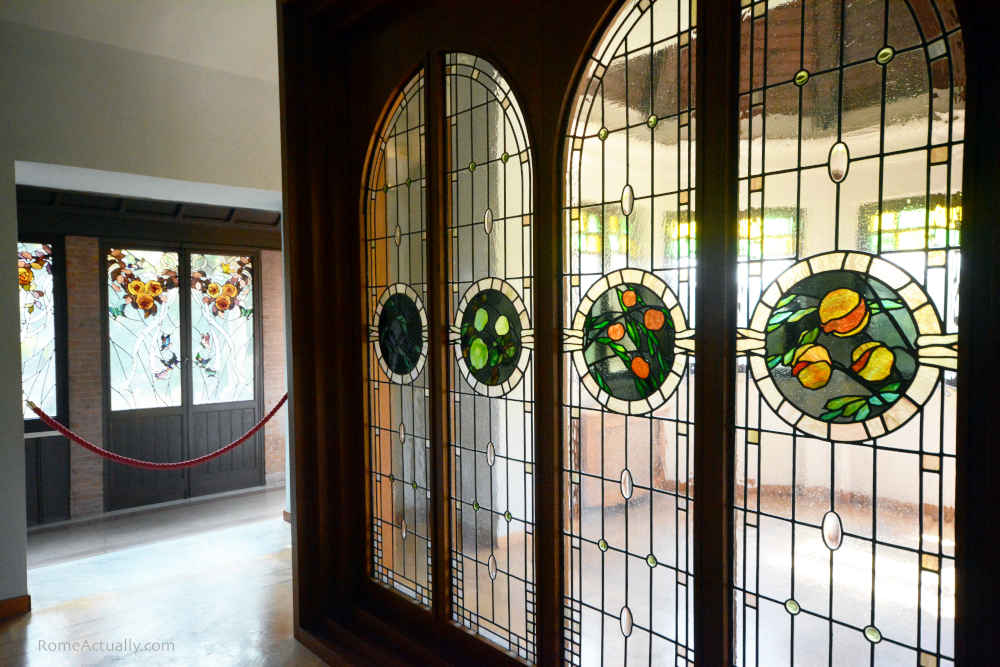
In its interior, Casina delle Civette shows great attention to the smallest detail and both floors appear well-finished and rich in decorative patterns and features such as paintings, stuccos, mosaics, polychrome majolicas, wrought iron, wall fabrics, elegant furnishing, carved woods, and marble sculptures. There is obvious attention to his own living comforts.
Even though much of the furniture was lost, entering Casina delle Civette immediately gives you an idea of the comfortable lifestyle the owner sought for himself, the cozy vibe he pursued, and the fine artistic sense he wanted his dwelling to convey.
This original artistic expression is the fil rouge that connects all the buildings of Villa Torlonia, a park that even though so much different from the more classic ones, perfectly fits and blends in the multifaceted history of the eternal city. The same neighborhood is one of a kind and although elegant and residential, it hides some fantastic Rome landmarks belonging to both ancient and modern times.
Rooms of Casina delle Civette
The rooms and halls of Casina delle Civette, while emptied by the stormy modern history of the neighborhood and city, reveal belonging to an upper class, an owner with a fine and sophisticated sense of beauty.
Stanza del chiodo (Room of the nail)
The name of this room was given after the large nail-shaped window, work by Duilio Cambellotti, decorated with vine leaves and bunches of grapes, the same pattern that we can see in the stucco work of the ceiling and on the tondo in the middle. This was the studio of the Torlonia prince but the furniture got lost.
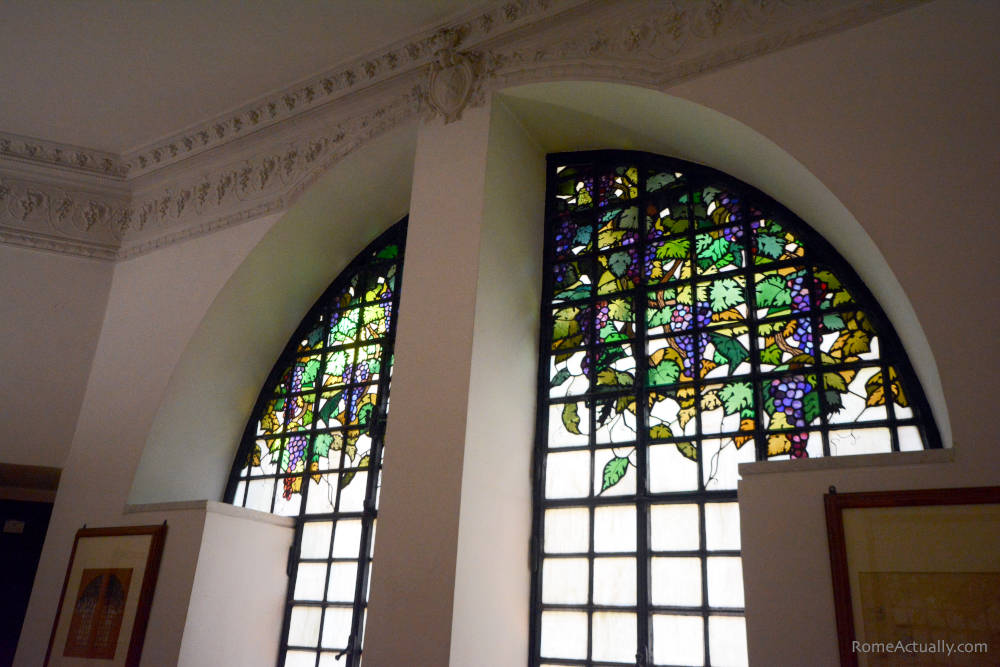
An interesting feature of this and also other rooms of Casina delle Civette is the display of drafts and sketches of the glass windows and walls decorating the area and also those of the ones that were in the project and either never made, got lost, or were aimed at other places.
Sala da pranzo (Dining hall)
A distinctive feature of this dining hall is the wooden wainscoting all around the walls and even frames the glass doors. The motifs decorating the wainscoting represent leafy branches and berries of the bay tree while inserts of lighter wood create a ribbon-like ornament.

The upper frames are made of round lighter wooden panels where in origin were placed ceramic plates with landscape sceneries which unfortunately have been lost. On top of the walls, framing the ceiling is a white stucco frieze with the same bay tree motifs.
The doors leading to the other rooms feature beautiful glasses decorated with grape shoots and leaves.
Stanza dei trifogli (Room of the shamrock)
The room of the shamrock owes its title to the recurring clover-themed decoration you will spot in the stucco work of the ceiling and the floor. The windows are made using a mixed technique and feature the crest of the Torlonia family with roses and comets in medieval style and underneath the rest of the window is decorated with bottle bases.
The only element of furniture that survived the devastation of the cottage is a 19th-century marble fireplace built in the Renaissance style. Displayed in the room are also a glass window painted with Biblical themes by Italian painter, engraver, illustrator, and decorator Paolo Paschetto, and sketches for the windows of the Waldensian church in Piazza Cavour.
Salottino delle 24 ore (24-hour parlor)
This small parlor is located in the octagonal cupola and bears the richest decoration among all the rooms of Casina delle Civette. As Jappelli built it in origin, this was a small kitchen, but with the following renovations, it became the lounge of Prince Giovanni.

The vault was painted with tempera by Roman artist Giovanni Capranesi in 1909 and is divided into eight panels in which we can appreciate the dance of the 24 hours among rose tendrils. These are represented by young girls draped with veils dancing in groups of three and with a sky-blue background with comets. This is a clear hint to the coat of arms of the Torlonia family.
The ceiling decoration features a central round rose framed with stucco. Here, too, the rose pattern is reiterated and the eight stucco reliefs show the Phoenix rising from the ashes. Again, a clear glorification of the Torlonia family through the symbols of eternity such as the hours and the Phoenix myth.
The colorful mosaic decorating the floor comes from Casino dei Principi, another cottage of the same Villa Torlonia park, while the walls were originally covered with fine silver and golden damask wall fabric that has unfortunately gone lost.
The prince’s bathroom
The bathroom of the prince is a small space where we can still understand that was finely adorned even though much of the decorative features are gone. These include beautiful majolicas with water lilies of which there are only a few samples preserved and reassembled.
The two peach-pine sideboards with enameled glass doors are the work of Duilio Cambellotti.
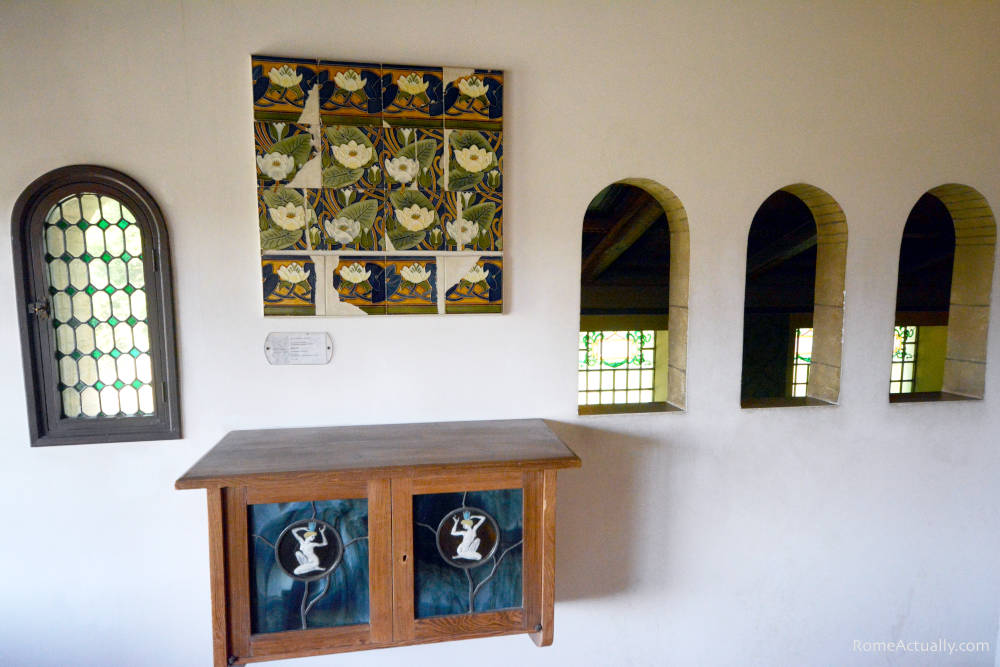
The prince’s bedroom
From local documents and literary sources, we know that this was the room that more than any other in the Casina delle Civette cottage showed the loner personality of its owner and its passion for symbols and birds such as the ever-recurring owls and night birds in general. Unfortunately, most of the ornaments and furniture of this room are lost, except for the round rose at the center of the ceiling depicting flying bats with black wings.
Some of the original furniture that we can still view in this room are a large mirror with a delicate ivy-motif incision, a desk with a leather top, and a bed headboard that probably wasn’t originally from here.
Stanza dei ciclamini (Room of the cyclamens)
This room of the Casina delle Civette is called this way because of the cyclamen-themed decoration of the marble tiles of the floor. It was mainly used as a guest room so it doesn’t have any personal objects or particular ornamental features apart from a gorgeous large window with two peacocks.

This is a beautiful and sophisticated window made of bright blue, yellow, and green glasses set into lead composing an elaborate design of six peacocks positioned in an ascending position around a large vase.
Guests’ bathroom
One of the last rooms worthy of mentioning and visiting is the guests’ bathroom. Even though smaller and not built for the owner’s use, it’s not less decorated than the first one I visited that was the personal bathroom of the Torlonia prince.

You can see the walls fully coated with majolicas of golden chain flowers and an elegant déco design on the upper layer. Apart from this, the main draw of this area of the house is yet another large Liberty-style window. This time, it’s made of three glasses, with the central one showing a lake landscape with a white swan, while the two side glasses are decorated with the flower patterns of iris and cattail.

Even though historians are not sure about the authors of these specific ornaments, it’s certain that they were part of the original house décor and show how important the glass was in the cottage as well as in the artistic landscape of the early 20th century.
Plan your visit to Casina delle Civette in Villa Torlonia
- Address: Via Nomentana 70.
- How to reach Casina delle Civette: By metro (Sant’Agnese Annibaliano and Bologna stops, B line), by bus (62, 66, 82), by tram (2, 3, 19).
- Opening hours: Tuesday to Sunday 9 am-7 pm. Closed on Monday.
- Entrance fee: The ticket for Casina delle Civette costs 6€, but if you want to visit more than one landmark, you can purchase a discounted collective ticket. These are the options: Casina delle Civette + Casino Nobile + Serra Moresca: €11.50; Casina delle Civette + Casino Nobile: €9.50.
- How to buy your ticket: The ticket offices of Villa Torlonia are in the Casino Nobile or the Serra Moresca (which opens at 10 am instead of 9 am). Casina delle Civette doesn’t have a ticket office. In the high season, it’s recommended to book your ticket online from the official website or over the phone by calling the number 060608. Pre-sale charge is 1€.

